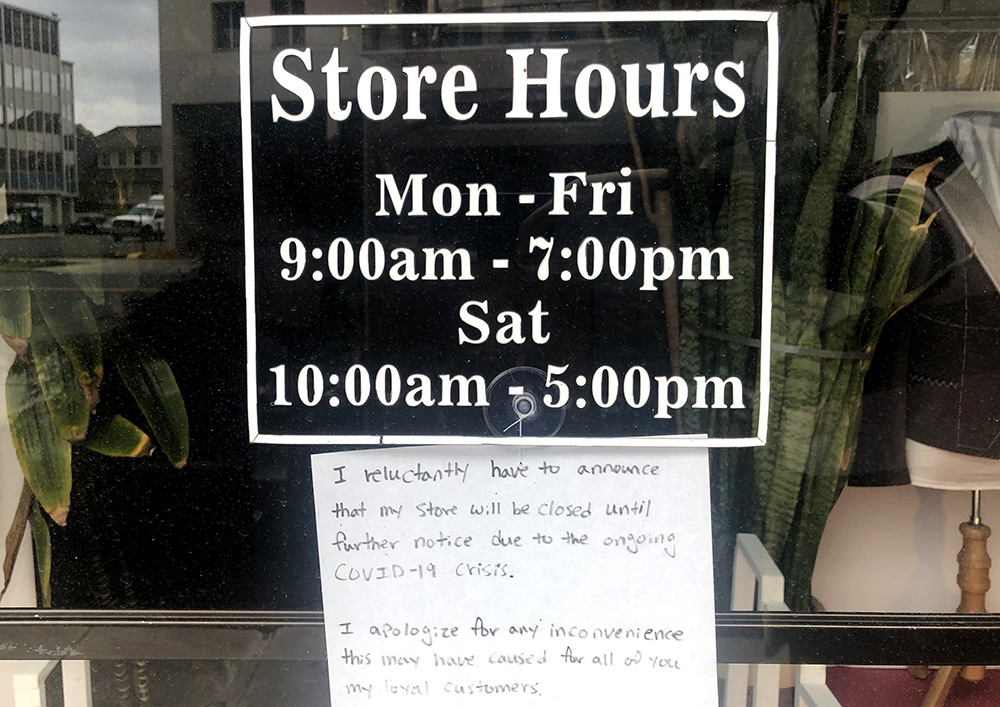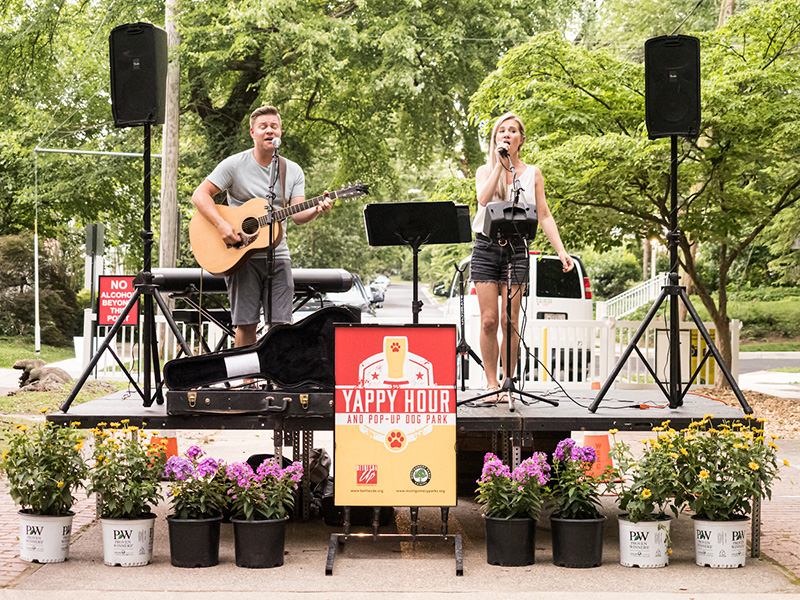
The retail that helps define Montgomery County’s character is struggling. The necessary COVID-19 restrictions that reduce crowds will continue to challenge retail in Montgomery County even after the lockdown eases, but the county has policies and programs that could help landlords, retailers, employees and the customers they serve.
Montgomery County’s extensive retail sector with 40.6 million leasable square feet across 2,390 properties (Source: CoStar) serves a diverse population and is a key amenity for the County. In their 2017 Retail Trends Study, the Montgomery County Planning Department highlighted vibrant, small retail businesses and recommended that the County would “benefit from focusing on the development and support of these unique small businesses, as these businesses are market differentiators for the DC area.” The County’s retailers of all sizes are also a key part of the economy as they employ 15 percent of workers across the Washington DC region.
However, due to COVID-19 restrictions and required social distancing, most retailers and restaurants (‘retail’ for simplicity) are struggling to survive. The Federal Emergency Management Agency estimates that 40 to 60 percent of small businesses fail following natural disasters such as floods while the Restaurant Association of Metropolitan Washington estimates that 25 to 30 percent of its members won’t outlast the novel coronavirus. Retail failure won’t be limited to small businesses as bankruptcy is affecting large department stores and entertainment companies that traditionally anchor shopping districts and generate foot traffic that supports other stores.
Although we do not yet know by how much retail vacancy will increase, there is no doubt that it will rise significantly. A recent Moody’s Analytics presentation estimated an increase in retail vacancy in the DC region from 9.5 percent to between 13 and 15 percent. Applied to Montgomery County’s 40.6 million square feet, this would imply an increase of 1.5 million to 2.2 million square feet of empty retail space. For scale, the Westfield Wheaton Mall, the largest retail property in the County, has approximately 1.5 million leasable square feet.
As the lockdown phase of the crisis eases, retailers will first face a period of partial reopening with the level of restrictions fluctuating in response to evolving conditions. A recent Bisnow article cited restaurant owners predicting a 50 percent drop in revenues during this partial reopening phase, a level insufficient to sustain many restaurants.
Once there is a vaccine and we begin the post-COVID-19 phase, it is unlikely consumers will return fully to their prior practices, particularly if the nation endures a lasting recession. Supporting the retail sector in both of these phases will be important and the following is a series of potential actions or policies that might assist existing retailers adapt to the post-COVID-19 environment and help fill the inevitable vacant spaces.
1. Allow Retailers to ‘Stretch out’ into Parking Areas and Public Streets

One way of easing the blow of mandatory distancing requirements inside retail establishments is to let retailers use more space. While not every business can physically expand, where available, the County might allow businesses to take over parking areas for sales space.
For properties with private parking this might involve temporary tents/structures or food trucks in the parking field. These structures could become cost-effective means of testing new retail concepts. The County could facilitate this by amending the zoning code to allow these structures/vehicles known as transitory uses to remain in place for greater than the current limit of 24 hours.
The County could permit business with street parking out front to use those spaces as well, akin to an extended PARK(ing) day. The County could also consider using underutilized parking fields for pop-up markets that retailers could place away from their permanent/physical location. Montgomery Planning created such pop-up markets as temporary placemaking exercises in Randolph Hills Shopping Center in 2018 and at the Burtonsville Crossing Shopping Center in 2019, both of which were well received by the community.
2. Temporary use of the Parks

Society retains the need for entertainment, exercise and interaction, but many of our theaters, entertainment spaces, gyms, and commercial venues contain chokepoints at stairs, doorways, entries that likely make them unsuitable to host crowds during the partial-reopening period. Initial research indicates that many activities are safer outdoors during this pandemic rather than indoors, leading to the logical conclusion that parks and the public realm will be critical assets during the recovery period.
Montgomery County’s parks might host appropriately spaced-out pop-up markets, temporary entertainment venues, and open-air fitness programs that enable crowd management without choke points. While outdoor performances, markets and fitness classes will not generate the same level of revenue as those in traditional structures, they could help some retailers, performance troupes and exercise companies survive while providing sorely needed entertainment and relief (at least until the weather turns cold again). Some areas in Montgomery County have already taken steps to utilize our outdoor space by temporarily closing some of our parkways to promote safe exercise.
3. Additional Targeted Small Business Assistance
As the economy begins to ultimately recover and restrictions lift, starting a new business or expanding an existing one will require significant capital investment and some of the shuttered commercial spaces will need renovation to prepare for new tenants. Montgomery County would benefit from a targeted recovery program to assist small business with start-up costs like business formation itself, renovation of space or façade improvements. This type of assistance is a staple of economic development and many municipalities operate similar programs. While these programs are not new, they will be even more important coming out of the COVID-19 crisis. Montgomery Planning and the University of Maryland Partnership for Action Learning in Sustainability (PALS) program did a recent study on small businesses in the Long Branch neighborhood of Silver Spring and recommended more such programs that provide targeted small business assistance.
This targeted recovery assistance for business formation and expansion is distinct from the recently created Montgomery County Public Health Emergency Grant Program. The PHEG program is designed to help small businesses survive the lockdown phase by providing emergency grants of up to $75,000 for employee wages and benefits, taxes, debt, rent or other operating losses.
4. Master/Model Leases
Reduced economic activity may spur utilization of a form of retail leasing known as participation rent in which the landlord receives a reduced guaranteed payment but receives a portion of the retailer’s revenues. This model transfers some of the risk from the retailer to the landlord but also gives the landlord a stake in the rewards. Large developers and chain retailers are more likely to be familiar with this lease structure than small landlords and independent retailers.
A model or sample lease with participation rent terms readily available could help reduce the risk for new independent retailers, increasing absorption of vacant space in the smaller buildings that comprise the bulk of retail properties. Montgomery County already offers sample leases for single family and multifamily properties to assist residential tenants and landlords. The idea for a commercial model lease originated with Montgomery Planning and the University of Maryland PALS retail study highlighted above.
5. Vacancy Tax
While the rise of retail vacancy will put pressure on landlords to lower rents to attract tenants, rents are notoriously sticky. It is a common refrain that landlords in soft markets too often leave retail empty rather than offering attractive rents. Montgomery County might consider a vacancy tax, a fee charged to landlords of empty retail spaces, adding pressure to reduce rents by increasing the cost of holding out for higher rents. Retail vacancy taxes and fees are in place in Arlington, MA, just approved in San Francisco, CA, and recently considered in New York and Boston.
To make this policy revenue neutral, Montgomery County might utilize any funds raised for additional targeted small business assistance, façade improvements or funding public space improvements within commercial corridors in ways that help fill vacant retail space.
Supporting Businesses and Restoring Consumer Confidence
It is inevitable that retail vacancy rates will rise as the stakeholders that influence the use of real estate (local government, private property owners, businesses and financial institutions) simply cannot prevent all aspects of this downturn. While this crisis is causing great pain for many existing retailers and accelerating trends transforming the sector, it may also prepare the ground for new innovations and ideas that regenerates our storefronts. Creative policies and actions could support our property owners and businesses and accelerate the restoration of consumer confidence.
Robert Oshel
Re: “To make this policy [a retail property vacancy tax] revenue neutral, Montgomery County might utilize any funds raised for additional targeted small business assistance, façade improvements or funding public space improvements within commercial corridors in ways that help fill vacant retail space.”
Using the proceeds of the tax for the suggested uses seems reasonable, but why should imposition of this tax be revenue neutral? County tax revenues are down and services are being cut or not expanded as needed. If a vacancy tax were to be imposed, there is no reason its revenue shouldn’t be used for funding the highest priority needs. Public space improvements within commercial corridors, etc., may not be the highest priority need.
Robert Smythe
I agree with Robert Oshel’s comment. Retail property vacancy taxes would help to make developers a little less greedy and should also be used for a range of public benefits. These could include more pedestrian-friendly walkways, more public green space (nearly non-existent in downtown Bethesda now), more local public transportation, more trees, and lots of other public amenities that County government has allowed developers to diminish or neglect entirely. Just do it! Robert Smythe